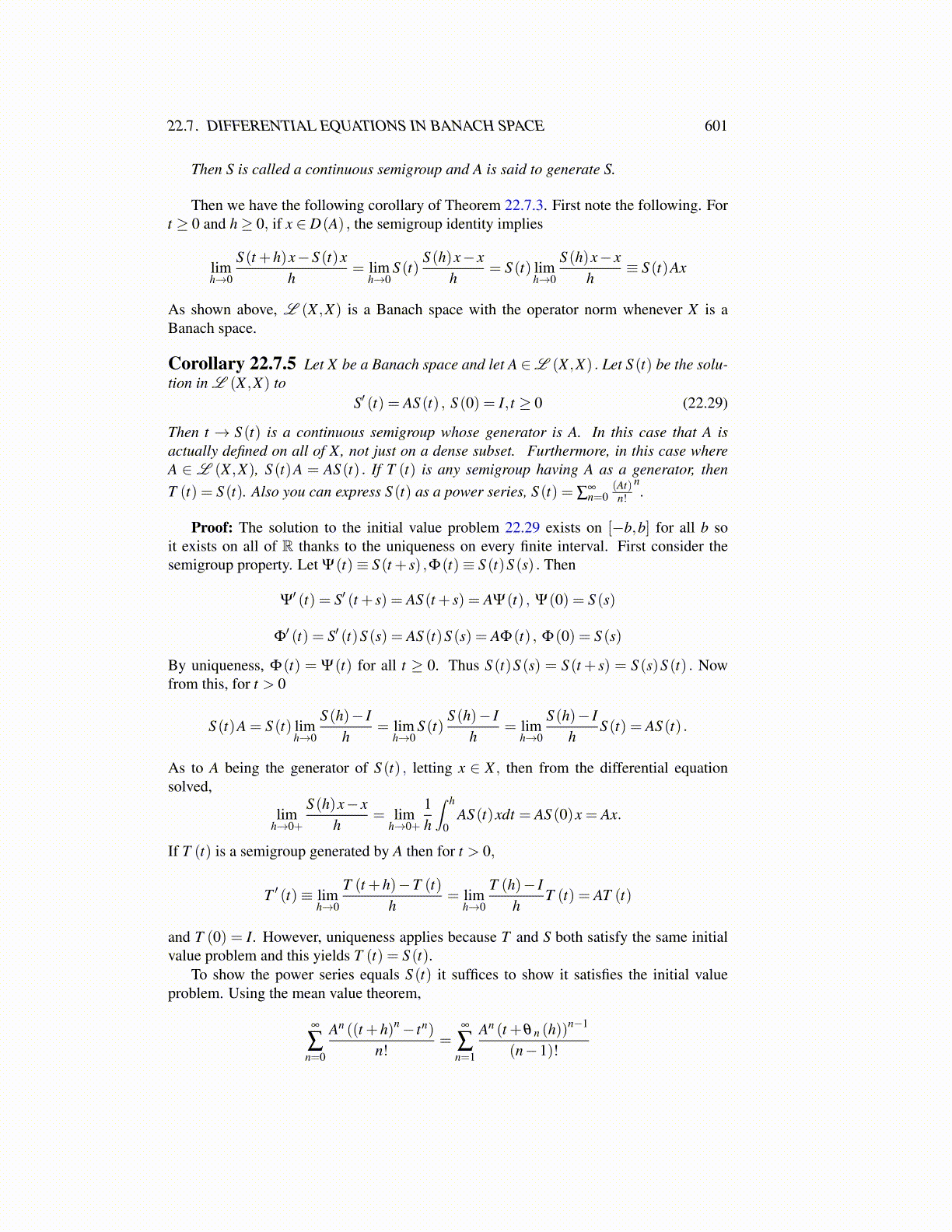
22.7. DIFFERENTIAL EQUATIONS IN BANACH SPACE 601
Then S is called a continuous semigroup and A is said to generate S.
Then we have the following corollary of Theorem 22.7.3. First note the following. Fort ≥ 0 and h≥ 0, if x ∈ D(A) , the semigroup identity implies
limh→0
S (t +h)x−S (t)xh
= limh→0
S (t)S (h)x− x
h= S (t) lim
h→0
S (h)x− xh
≡ S (t)Ax
As shown above, L (X ,X) is a Banach space with the operator norm whenever X is aBanach space.
Corollary 22.7.5 Let X be a Banach space and let A ∈L (X ,X) . Let S (t) be the solu-tion in L (X ,X) to
S′ (t) = AS (t) , S (0) = I, t ≥ 0 (22.29)
Then t → S (t) is a continuous semigroup whose generator is A. In this case that A isactually defined on all of X, not just on a dense subset. Furthermore, in this case whereA ∈ L (X ,X), S (t)A = AS (t) . If T (t) is any semigroup having A as a generator, thenT (t) = S (t). Also you can express S (t) as a power series, S (t) = ∑
∞n=0
(At)n!
n.
Proof: The solution to the initial value problem 22.29 exists on [−b,b] for all b soit exists on all of R thanks to the uniqueness on every finite interval. First consider thesemigroup property. Let Ψ(t)≡ S (t + s) ,Φ(t)≡ S (t)S (s) . Then
Ψ′ (t) = S′ (t + s) = AS (t + s) = AΨ(t) , Ψ(0) = S (s)
Φ′ (t) = S′ (t)S (s) = AS (t)S (s) = AΦ(t) , Φ(0) = S (s)
By uniqueness, Φ(t) = Ψ(t) for all t ≥ 0. Thus S (t)S (s) = S (t + s) = S (s)S (t) . Nowfrom this, for t > 0
S (t)A = S (t) limh→0
S (h)− Ih
= limh→0
S (t)S (h)− I
h= lim
h→0
S (h)− Ih
S (t) = AS (t) .
As to A being the generator of S (t) , letting x ∈ X , then from the differential equationsolved,
limh→0+
S (h)x− xh
= limh→0+
1h
∫ h
0AS (t)xdt = AS (0)x = Ax.
If T (t) is a semigroup generated by A then for t > 0,
T ′ (t)≡ limh→0
T (t +h)−T (t)h
= limh→0
T (h)− Ih
T (t) = AT (t)
and T (0) = I. However, uniqueness applies because T and S both satisfy the same initialvalue problem and this yields T (t) = S (t).
To show the power series equals S (t) it suffices to show it satisfies the initial valueproblem. Using the mean value theorem,
∞
∑n=0
An ((t +h)n− tn)
n!=
∞
∑n=1
An (t +θ n (h))n−1
(n−1)!